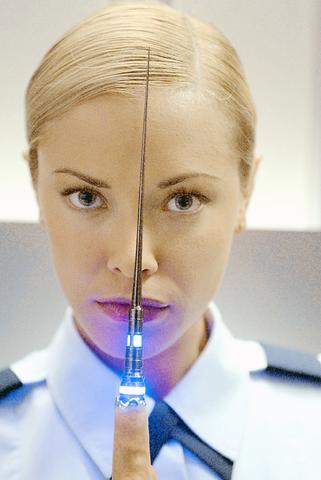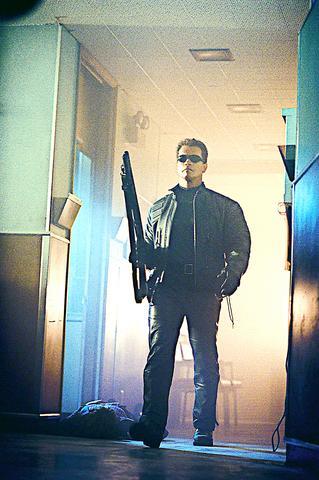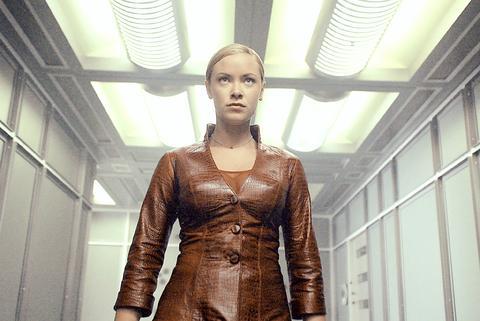In Terminator 3: Rise of the Machines, just as in T2 a dozen years ago, the original T-1 killer cyborg from the future, played by Arnold Schwarzenegger, does battle on the streets of Los Angeles with an updated, sleeker, deadlier model.
Last time, you may recall, it was the T-1000, played with metallic sangfroid by Robert Patrick. Now, in an apparent concession to the turbo-feminist lad-mag action-movie times, the state-of-the-art killer cyborg from the future is the T-X, who touches down on Rodeo Drive in the arresting and unclothed form of Kristanna Loken, and who goes about her subsequent business in a red leather pantsuit and a silver Lexus coupe.
The old-model Terminator, delivering his weary one-liners in that familiar Austro-Californian monotone, has his hands full with this limber, ruthless new machine, who has been sent back in time, as Schwarzenegger was in the first Terminator movie, to kill off the future leaders of human resistance to machine tyranny.

PHOTO COUTESY OF BUENA VISTA
This movie must struggle with its own potential obsolescence. The first instalment in the franchise, directed by James Cameron and starring Linda Hamilton along with Schwarzenegger, is nearly 20 years old; its sequel was released when the current president's father was in the White House. The rapid evolution of special-effects technology since then, and the concurrent spread of multi-sequel blockbuster franchises, give those influential pictures a decidedly antique aura.
In part because of the example of Terminator 2, which was a pioneer in the use of computer-animated imagery in a live-action setting, sci-fi action movies have become ever more visually elaborate -- and also more pretentious. Next to the baroque postmodern pseudo-sophistication of the Matrix movies, which similarly explore the fate of humanity under threat of machine dominance, the new Terminator has a lumbering, literal-minded old-style feel.
Which is not, on balance, such a bad thing. Cameron has long since ascended from action auteur to king of the world, leaving his dueling robots and their human prey in the hands of Jonathan Mostow. Mostow's previous film was U-571, a highly competent exercise in that squarest of all action subgenres, the submarine movie. And if he lacks Cameron's unusual gift for finding human drama amid all the explosions, chases and collisions, Mostow does at least film the explosions, chases and collisions with professionalism and something like wit.

PHOTO COUTESY OF BUENA VISTA
Though not, it must be said, with brevity. On my way into the screening room I was heartened to hear that the movie's running time was a relatively brisk 109 minutes. But the first big highway screech-and-bang sequence -- a big-wheeled menage a trois with the good Terminator in a fire engine, the bad Terminatrix behind the wheel of a construction crane and the poor human afterthoughts in a swaybacked Toyota Tundra -- felt at least that long.
Afterward, if your auditory nerves have not sustained permanent damage, you will hear some necessary explanations, which complete the epic voice-over of the opening scenes. The heroic resistance of Sarah Connor (Hamilton) in T2 did not prevent the apocalyptic ascent of the techno overlords, but only postponed it. Now, Sarah's son, John (Nick Stahl), the prophesied leader of the human resistance, is living "off the grid," haunted by nightmarish visions of global catastrophe.
His designated love interest, played by Claire Danes, is Kate Brewster -- or, as she is marvelously described in the Warner Brothers press kit, "unsuspecting veterinarian Kate Brewster." Unsuspecting has a disposable fiance, who is quickly disposed of, and a military dad (just like Jennifer Connelly in The Hulk), who is in charge of the high-tech weapons system that will soon take over the world, wipe out most of the human race and send killer cyborgs from the future to deal with the remnant. Unless of course Veterinarian and her future husband -- as opposed to her disposable fiance -- can prevent all of this from happening.

PHOTO COUTESY OF BUENA VISTA
I won't give away the ending. But even if I did, it wouldn't be the end of the world. For all the hype and the inevitable (and most likely short-term) box office bonanza, Terminator 3 is essentially a B movie, content to be loud, dumb and obvious, and to leave the Great Ideas to bona fide public intellectuals like Keanu Reeves and the Hulk. Schwarzenegger, whose main contribution to US culture has been inspiring wicked parodies on Saturday Night Live and The Simpsons, acts (if you can call it that) with his usual leaden whimsy, manifesting the gift for uttering hard-to-forget, meaningless catchphrases that is most likely the wellspring of his blossoming reported desire to seek elective office in California.
This Terminator professes not to recall ever having said "hasta la vista, baby," but he does let fly with gems like "I'm back," "She'll be back," and "My database does not encompass the dynamics of human pair-bonding." He also says, "You're terminated" to his robot rival, perhaps testing out a slogan intended for poor Gray Davis. But that's the next sequel.

PHOTO COUTESY OF BUENA VISTA

PHOTO COUTESY OF BUENA VISTA

Taiwan Power Co (Taipower, 台電) and the New Taipei City Government in May last year agreed to allow the activation of a spent fuel storage facility for the Jinshan Nuclear Power Plant in Shihmen District (石門). The deal ended eleven years of legal wrangling. According to the Taipower announcement, the city government engaged in repeated delays, failing to approve water and soil conservation plans. Taipower said at the time that plans for another dry storage facility for the Guosheng Nuclear Power Plant in New Taipei City’s Wanli District (萬里) remained stuck in legal limbo. Later that year an agreement was reached

What does the Taiwan People’s Party (TPP) in the Huang Kuo-chang (黃國昌) era stand for? What sets it apart from their allies, the Chinese Nationalist Party (KMT)? With some shifts in tone and emphasis, the KMT’s stances have not changed significantly since the late 2000s and the era of former president Ma Ying-jeou (馬英九). The Democratic Progressive Party’s (DPP) current platform formed in the mid-2010s under the guidance of Tsai Ing-wen (蔡英文), and current President William Lai (賴清德) campaigned on continuity. Though their ideological stances may be a bit stale, they have the advantage of being broadly understood by the voters.

In a high-rise office building in Taipei’s government district, the primary agency for maintaining links to Thailand’s 108 Yunnan villages — which are home to a population of around 200,000 descendants of the Chinese Nationalist Party (KMT) armies stranded in Thailand following the Chinese Civil War — is the Overseas Community Affairs Council (OCAC). Established in China in 1926, the OCAC was born of a mandate to support Chinese education, culture and economic development in far flung Chinese diaspora communities, which, especially in southeast Asia, had underwritten the military insurgencies against the Qing Dynasty that led to the founding of

Artifacts found at archeological sites in France and Spain along the Bay of Biscay shoreline show that humans have been crafting tools from whale bones since more than 20,000 years ago, illustrating anew the resourcefulness of prehistoric people. The tools, primarily hunting implements such as projectile points, were fashioned from the bones of at least five species of large whales, the researchers said. Bones from sperm whales were the most abundant, followed by fin whales, gray whales, right or bowhead whales — two species indistinguishable with the analytical method used in the study — and blue whales. With seafaring capabilities by humans